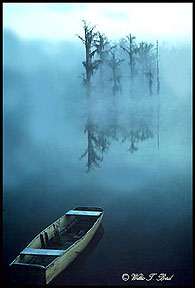
Fig.1
Ever have one of those days? Dad calls out, “Hey! Take the garbage out!” Or Mom says, “Those dishes aren’t going to wash themselves!” Your reply may be, “I’m not in the mood!”
Let’s see what the dictionary says about “mood.” “Mood: n. 1. A person’s emotional state or outlook. 2. a prevailing emotional tone or general attitude.” (From the Random House: Webster’s School & Office Dictionary). Your response to your parents’ directives would fit the “…general attitude” part of the definition of “mood.” In fact, there would probably be few times when your attitude would be any more positive about those two projects–right? But, in this case, we’re talking about photography and how mood plays–or can play–a big part.
Many times, we want our photos to evoke a specific mood in the person viewing them. Quite often, we’d like the viewer to feel the same way we felt when we took the shot. Other times, we may want simply to throw the photo out there to see what it does to the other person. You might be surprised at the emotions you inspire. They may range from surprise to laughter to anger. Your photograph might bring a warm and fuzzy feeling or a feeling of dread.
I’ve found that two of the biggest factors in setting mood are light and weather. Early mornings and late afternoons give the best lighting to create a moody scene. Fog, rain, and/or clouds add drama. Many a new photographer has planned a shoot only to awaken to find the big day is rainy or foggy. She crawls back in bed, pulls up the covers, and goes back to sleep. But enjoying extra sleep isn’t all she does…she misses one of the best opportunities to create a spectacular photo she might ever have.
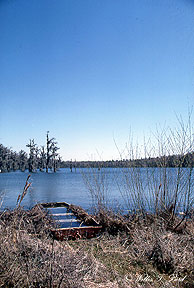
Fig. 2
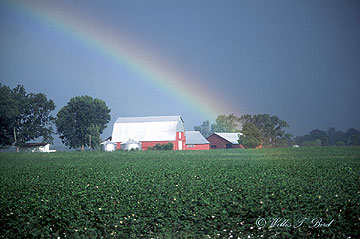
Fig. 3
One shot that has been a favorite seller for me I entitled Misty Morn (fig.1). It was taken early one foggy morning as I stopped by a pond on the way to work. (Remember to keep your camera with you, or you’ll miss great shots.) I’ve included another shot, from nearly the same place, of a similar subject taken at mid-day to show you the contrast (fig.2). While the latter image might be a nice snapshot, the foggy shot is the one that evokes the oohs and ahhs. Although the perspective and lens size are also different, the main difference is the lighting and the moody weather conditions.
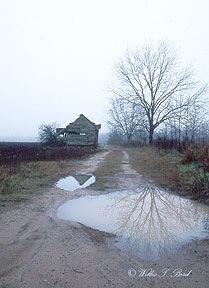
Fig. 4
Another example of being ready even in poor conditions is represented by a shot I took a few months ago entitled Rainbow Farm (fig.3). That day, I went out in my car looking for interesting cloud formations, not expecting a shower. With so many unusual clouds around, I thought I might be able to use a few with interesting landscapes beneath. Suddenly, I found myself in a brisk shower. Lo and behold, a beautiful rainbow appeared before me. However, there was nothing to pair it with for impact. In a flash, I remembered a farm I’d seen on that same road. I sped up, hoping to arrive before the beautiful rainbow disappeared. As I approached the farm, I noticed that the rainbow was to the left of the road and the farm was on the right. I was disappointed until I remembered that before I reached the farm, I had seen another road that turned to the right. I took that road. It lined up the rainbow with the farm perfectly. From the shelter of my automobile, I took the shot through the rain with no filters of any kind. If I hadn’t gone out on that windy day, I would’ve missed a once-in-a-lifetime shot. But my “luck” also required a little work on my part to make the rainbow and the farm come together for the photograph.
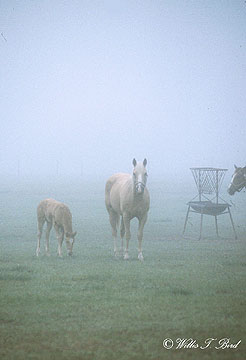
Fig. 5
Several years ago, Hurricane Opal came through part of the country. Trees and power lines were strewn across the ground. The hurricane raked the countryside clean, removing many old sheds and trees. When I could get my car out, I went searching for photos. After what had been a fury of ninety-plus mile-per-hour winds a day or two before, I came across this peaceful scene created by Man and the storm in conjunction with each other. It is entitled Rainy Reflections (Fig.4).
At this point, I might add a note of caution. When going out in rain, snow, or other conditions that are less than perfect, be very careful. Let someone know where you’re headed and when to expect you back. Bring a cell phone or someone else with you. Don’t take dangerous, foolhardy chances. No photo is worth your life. The truth is, you don’t have to wait for storms to get good moody photographs. Sunsets and sunrises also qualify as mood shots. Good examples appear in most photographers’ books.
I like to watch for foggy mornings when the weather is slipping from summer to fall or from fall to winter. When I hear that the weather forecast is for fog for a morning or two, I head south about a hundred miles to the coast to look for one of my favorite shots. Often, sea birds will make an appearance in my images as well as old fishing boats. But sometimes the fog comes inland, and good shots can be found nearer home–such as the one of the horses in Fig.5. The fog deletes all the background clutter that might detract from the subject and leaves the subject highlighted. Clouds can also produce dramatic landscapes. Rain on tree trunks can alter the look dramatically.
I may not be in the mood when I first go out to take a photo with emotional impact, but by the time I come back, I’m definitely there. You will be, too. So, go get some weather-related shots. Get in the mood…but empty the garbage and do the dishes first!
By Willis T Bird

Leave a Reply